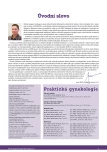Hysteroscopy in diagnostics and therapy in infertile patients.
Authors:
B. Babjak; B. J. Eim
Authors‘ workplace:
Nemocnice Vyškov p. o.
; Gynekologicko‑porodnické oddělení
Published in:
Prakt Gyn 2009; 13(1): 18-22
Overview
Hysteroscopy ranks among miniinvasive surgery procedures and have become gold standard in intrauterine diagnostics. It is also one of „see and treat“ techniques, so the surgeon can solve the problem immediately. Hysteroscopy is an important method in solving of uterine factor of infertility. It provides optical evaluation of the cervical canal and uterine cavity and carry out the endometrial biopsy. The main advantage of hysteroscopy over hysterosalpingography and ultrasonography is the capability of inspecting the uterine cavity. The most important intrauterine pathologies are: endometrial polyps, uterine fibroids, synechiae, and uterine congenital malformations. Hysteroscopy is particularly accurate in the assessment of all this pathologies. It is now possible to perform a comprehensive endoscopic examination of the uterine cavity in an office session without using any type of anesthetic or dilating the cervical canal. The development and fine tuning of this diagnostic technique have been aimed at making it a routine examination, harmless and reproducible, which does not require any premedication or anesthesia and which reduces patient discomfort to the minimum. There is lower rate of intra and postoperative morbidity compared to traditional surgery. Combining this method with laparoscopy improves the evaluation of pelvic anatomy.
Key words:
infertility – hysteroscopy – endometrial polyps – fibroids – intrauterine adhesions
Sources
1. Cittebart K et al. Gynekologie. 1. ed. Praha: Galén 2001.
2. Holub Z, Kužel D et al. Minimálně invazivní operace v gynekologii. 1. ed. Praha: Grada Publishing 2005.
3. Tools to optimize the IVF-ET procedure and its cost‑effectiveness. National Institute for Clinical Excellence: guidelines February 2004. London: RCOG Press, 2004.
4. Feghali J, Bakar J, Mayemar JM et al. Systematic hysteroscopy prior to in vitro fertilization. Gynecol Obstet Fertil 2003; 31: 127–131.
5. Takahashi K, Mukaida T, Tomiyama T et al. High pregnancy rate after hysteroscopy with irrigation in uterine cavity prior to blastocyst transfer in patients who have failed to conceive after blastocyst transfer. Presented at the 56th Annual Meeting of the ASRM. San Diego, California, USA. Program Suppl 2000; 74, P–355.
6. Clevenger-Hoeft M, Syrop CH et al. Sonohysterography in premenopauzal women with and without abnormal bleeding. Obstet Gynecol 1999; 94: 516–520.
7. Silberstein T, Saphier O, Voorhis B et al. Endometrial polyps in reproductive-age fertile and infertile women. IMAJ 2006; 8: 192–195.
8. Peršín J, Hanousek L, Mrvová V. Výsledky transcervikální chirurgické léčby polypů endometria. Čes Gynek 2005; 70(4): 273–276.
9. De Waay DJ, Syrop CH, Nygaard IE et al. Natural history of uterine polyps and leiomyomata. Obstet Gynecol 2002; 100: 3–8.
10. Bajekal N, Li TC. Fibroids, infertility and pregnancy wastage. Hum Reprod Update 2000; 6: 614.
11. Poncelet C et al. Myoma and infertility: analysis of the literature. Gynecol Obstet Fertil 2001; 29: 413.
12. Huvar I, Tinga D, Pilka L. Hysteroskopická resekce myomů. Čes Gynek 1994; 59(3): 114–116.
13. Kužel D. Hysteroskopie v terapii děložních myomů. Čes Gynek 2003; 68(2): 133–135.
14. Hamou J, Saegler AM. Diagnosis and treatment of intrauterine adhesions by minihysteroscopy. Fertil Steril 1983; 39: 321–326.
15. Taylor PJ, Leader A, George RE et al. Correlations between laparoscopic and hysteroscopic findings in 497 women with otherwise unexplained infertility. J Reprod Med 1984; 29: 137–140.
16. Kučera E, Křepelka P, Krofta L et al. Těhotenské komplikace po intrauterinní hysteroskopické chirurgii. Čes Gynek 2005; 70: 312–316.
17. Saravelos SH, Cocksedge KA. Prevalence and diagnosis of congenital uterine anomalies in women with reproductive failure. Hum Reprod Update 2008; 6.
18. Kužel D. Gynekologická endoskopie. Praha: Galén 1996.
19. Homer HA, Li TC, Cooke ID. The septate uterus: a review of management and reproductive outcome. Fertil Steril 2000; 73: 1–14.
20. Valle RF. Tubal cannulation. Obstet Gynecol Clin North Am 1995; 22(3): 519–540.
21. Brinsden PR. Textbook of in Vitro Fertilization and Assisted Reproduction: The Bourn Hall Guide to Clinical and Laboratory Practice. London: Taylor & Francis 2005.
Labels
Paediatric gynaecology Gynaecology and obstetrics Reproduction medicineArticle was published in
Practical Gynecology

2009 Issue 1
Most read in this issue
- Untypical Course of Pneumonia in Pregnancy: a Case Report
- Hysteroscopy in diagnostics and therapy in infertile patients.
- Upper Limb Lymphedema after Brest Cancer Therapy
- Forensic Aspects of Assisted Reproduction in Czech and Slovak Legislation.
